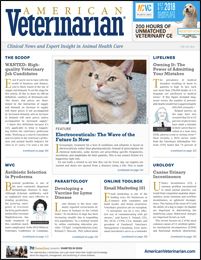The Information Revolution: We Can All Benefit
Technology continues to be a primary driver, and consumers are winning in terms of the convenience, breadth, and accessibility of content.

Every political or social revolution forces, winners, and losers. The same is true for the ongoing information revolution: Technology continues to be a primary driver, and consumers are winning in terms of the convenience, breadth, and accessibility of content.
The casualties of this revolution have included traditional news outlets such as newspapers and television, which have been replaced by social media as the most popular source of news. To survive in this tumultuous era, shrewd content producers know that their value and future depend on their ability to consistently provide reliable, useful information.
This is sound advice not only for the American Veterinarian® content platform but for veterinary practices as well. The digital revolution has given practices an unprecedented opportunity to reach pet owners and grow their businesses.
At the FUSE technology and media conference last fall, conference chair Jeffrey Litvack highlighted important trends that publishers should be translating into strategies for growth.1 Content personalization is increasingly crucial, he said; 56% of websites and 67% of emails have some level of personalization, and consumers are responding positively.
Litvack also noted that reader engagement with newsletters continues to rise. Time spent on email increased by 17% from 2015 to 2016 with,2 perhaps not surprisingly, millennials spending more time with email than any other age group—all because of their phones.
In light of this information, American Veterinarian® is improving the services we offer to veterinary professionals. We recently upgraded our email platform to help optimize subscribers’ experience. Recipients may not notice a difference, but that’s the point: We want to continuously and seamlessly improve the user experience and are investing in systems to do this.
All of our newsletters link to our websites, which offer a host of articles and videos covering not only clinical news and information but also practice management and business-related content that you can use to improve your online presence and build your business.
Is your practice website engaging and interactive? Is it updated regularly? Does it contain a library of articles and blogs that pet owners can turn to when they have questions related to the health of their 4-footed family members? Is your website mobile- friendly? Does it spur the user into action?
Do you send a practice newsletter to your clients? Are you following email best practices? Are your emails personalized? Do they offer a link for recipients to visit your website, Facebook, Instagram, or Pinterest page? Do you use your newsletter as a vehicle for asking your clients to leave online reviews for your practice? Does your newsletter convey trust and a sense of partnership?
If you answered no to most of these questions, then it’s probably time to rethink your electronic marketing strategy. To remain engaged with current clients and win new customers, practices today absolutely must be using technology to their advantage. We are committed to helping veterinary practices—and their clients and patients—be counted among the winners in the information revolution.
